If My Dog Eats a Grape What Do I Do
Updated March 26, 2021
If you're a dog owner, it's almost inevitable that you'll find a lump at some point. Dogs get lots of lumps and bumps, especially as they get older. How do you tell which ones are more serious?
Later I'll show you a large gallery of pictures and descriptions of the most common lumps of dogs.
Which Dog Lumps Need Removal?
Some of the ways you can identify a dangerous lump are:
- Speed: if a lump looks bigger in only a month it's growing rapidly
- Shape: smooth, round lumps whether on or under the skin are usually worse
- Appearance: black, pink or ulcerated surfaces are more worrying
- Feel: subcutaneous lumps should move easily between the skin and the body
- Position: watch out for lumps on the head, legs and tail (I'll explain later)
The only way to know for sure is to take a biopsy. That's where we take a small piece and get it examined. A biopsy does two important things:
- It tells us whether the lump is dangerous or not
- It helps us decide how big a surgical margin we need
Common Lumps Of Dogs
So the earlier we see a lump, the more options we have. If you're afraid of bad news, don't be; despite the horror stories, a biopsy or surgery isn't always needed, and most lumps are benign. Your vet can even identify most lumps straight away. Here's what they are and how we can tell.
See also: Common Mouth Lumps Of Dogs, Skin Cancer in Dogs and A Lump Below The Eye
Lipoma or Fatty Growth
What they are: the classic lump under the skin of older dogs. It's actually a benign tumour of fat cells, and should grow so slowly it takes 6 months to see any change. Most often found on the chest or abdomen.
How we tell: a fine needle aspiration (FNA) gives a clear answer. Never assume a lump is a lipoma unless your vet has done this first.
Treatment: none, usually. Lipomas need removal only when they occur in difficult positions like the legs or armpits. I also take them off younger dogs if they will get huge in a normal lifespan.
See pictures of lipomas and similar lumps under the skin here.
Soft Tissue Sarcoma
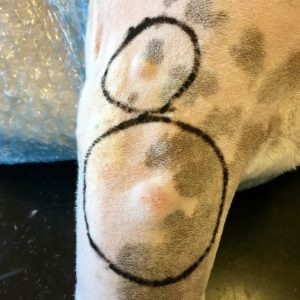
What they are: fast-growing, locally invasive tumours of connective tissue, common in large breeds.
How we tell: biopsy is necessary. Sarcomas feel just like lipomas and are often mistaken for these if a needle aspirate isn't done. A clue in this case is the position; lipomas are rarely on the legs.
Treatment: prompt, careful resection with a wide margin. The picture shows a fibrosarcoma on a leg with a standard 2cm margin. I hope you can see why the earlier we check these lumps, the better.
Sebaceous Cyst
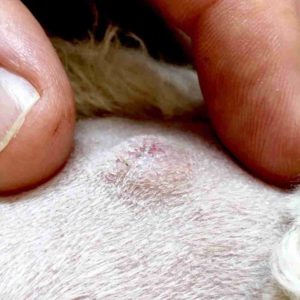
What they are: a blocked sebaceous gland causes a buildup of hard, cystic material attached to and under the skin. Note in the picture how the skin surface is reasonably normal-looking.
How we tell: a fine needle aspiration is necessary to distinguish from other masses.
Treatment: none, usually. Most sebaceous cysts never cause problems though occasionally they will burst.
Sebaceous Adenoma
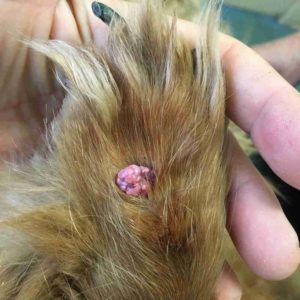
What they are: a benign tumour of sebaceous glands, often wrongly called a wart. Very common in Poodles, Maltese, Bichons and their crosses. This one is on an ear.
How we tell: biopsy is necessary, however, the classic appearance and slow growth make us near-certain just by looking.
Treatment: most sebaceous adenomas never cause problems, but any that are ulcerated or being licked need removal.
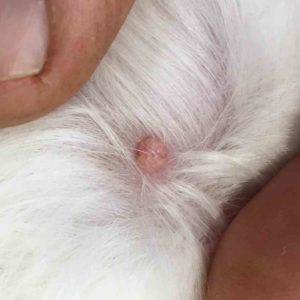
Here's another sebaceous adenoma, showing what they look like when small.
Papilloma or Wart
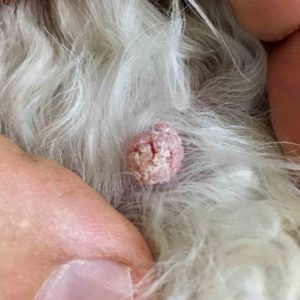
What they are: multiple small lumps often on the face and head of young dogs. Just like in humans, warts are caused by a papillomavirus; dogs that get them often go to dog parks or day care.
How we tell: biopsy is necessary, however, their classic feathery appearance is hard to mistake.
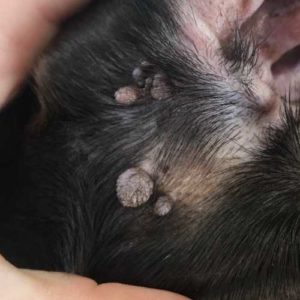
Treatment: none. Although they can look terrible, warts should go away by themselves after a few months.
Here are a group of warts on the ear and side of the head. See also: pictures of dog warts in the mouth.
Skin Tag
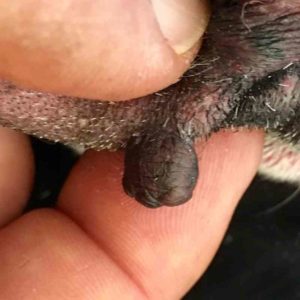
Skin tags are very similar to warts except they are usually smooth, long and narrow. They grow extremely slowly and pose no threat. The one pictured is quite large, and unusual in being pigmented, not pink.
Skin tags may start with anything that causes skin damage, such as papilloma virus, injuries, abrasion or infection.
Mast Cell Tumour
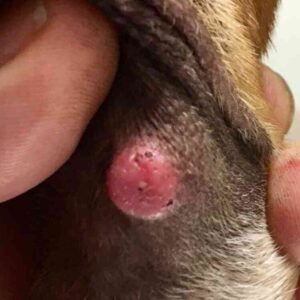
What they are: fast-growing, pink button-like lumps which can be well-behaved or very aggressive. They can also look like the sarcoma above. MCTs have a reputation for recurring following incomplete removal.
How we tell: your vet can usually do it via fine needle aspiration (see earlier) but sometimes a biopsy is required.
Treatment: should always be removed with a margin depending on the 'grade' or severity. Read here about new treatments for mast cell tumours.
Histiocytoma
What they are: fast-growing, pink button-like lumps that look identical to mast cell tumours when small. However, they are usually found in dogs under a year of age and will often stop growing and shrink all by themselves.
How we tell: a fine needle aspiration is helpful, as is the age of the dog.
Treatment: If the lump starts shrinking in 2 weeks, no treatment is necessary. Otherwise, we often remove these just to be sure.
Granuloma
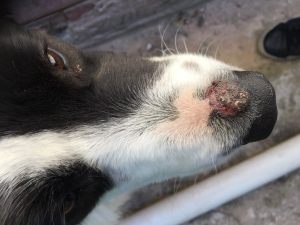
What they are: fast-growing, raised red lumps sometimes with a surface crust. Granulomas look like aggressive tumours but are actually a solid form of bacterial infection.
How we tell: sometimes a biopsy is required but we are often sure enough just from inspection.
Treatment: antibiotics, not surgery.
Melanoma
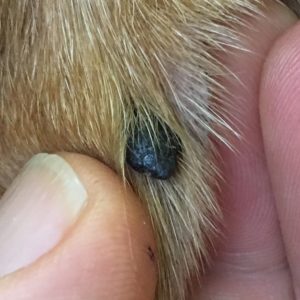
What they are: slow-growing, dark lumps not caused by sunlight. Skin melanomas of dogs need removal, but they are a lot less malignant than human ones and shouldn't make you lose sleep.
How we tell: there isn't much else that's black.
Treatment: removal. Baxter (pictured) gets repeated melanomas. After removing the first few we have been watching his latest set for signs of growth.
Haemangioma and Squamous Cell Carcinoma
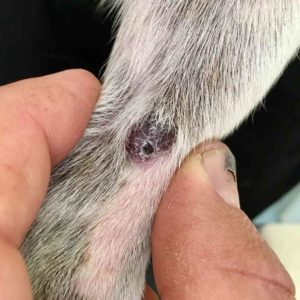
What they are: two tumours caused by ultraviolet damage from sun exposure, common in Adelaide on unpigmented areas of sunbathing dogs. You can see that the one on the dog's leg has started on a pink area.
How we tell: haemangiomas are red, berry-like masses that bleed easily; squamous cell carcinomas are raised, crusty sores.
Treatment: removal. SCC, in particular, can spread to lymph nodes and cause death if left too long.
Perianal Adenoma
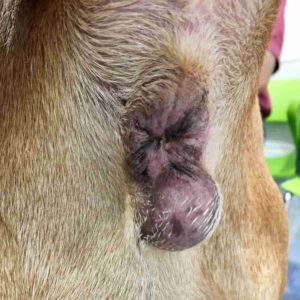
What they are: benign tumours found especially around the anus or the underside of the tail
How we tell: position and slow growth, plus their strong association with entire males or late desexing (though we occasionally also see them in females and neutered males too)
Treatment: removal, best done as soon as possible given the tricky location. This one is bigger than ideal.
Follicular Cysts
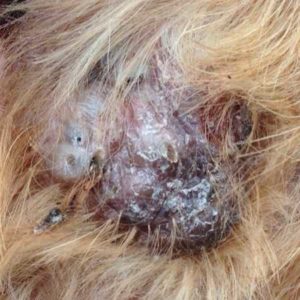
Follicular cysts are rare skin lumps caused by dilation and rupture of hair follicles. Although they may look like tumours, they are benign and usually easy for your vet to remove under anaesthetic.
A Mystery Lump
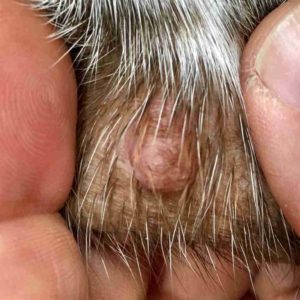
This one we also see frequently. It's very soft and squishy, has an irregular outline and is extremely slow growing. I have never needed to have one removed or tested.
Phew! There are lots of rarer lumps on and under the skin but I hope you'll never see them. For example, the other one at the start is a Sertoli Cell Tumour caused by a retained testicle. No dog should suffer from any of even the worst of these tumours if you get them checked in time.
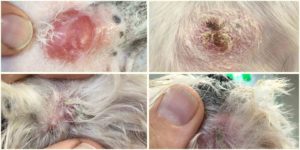
Even rarer is the last one. You can read more about epitheliotropic lymphoma here.
Note: Comments are now closed but you should find all the common questions answered if you scroll through them! I apologise that I'm unable to comment further on animals which we can't see personally in the clinic.
Have something to add? Comments are welcome below and will appear within 24 hours.
By Andrew Spanner BVSc(Hons) MVetStud, a vet in Adelaide, Australia. These help topics are from a series regularly posted on email and Twitter. Subscribe via email here to never miss a story! The information provided here is not intended to be used as a substitute for going to the vet. If your pet is unwell, please seek veterinary attention.
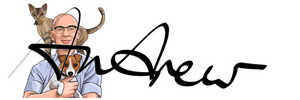
If My Dog Eats a Grape What Do I Do
Source: https://www.walkervillevet.com.au/blog/help-dog-lump/
0 Response to "If My Dog Eats a Grape What Do I Do"
Post a Comment